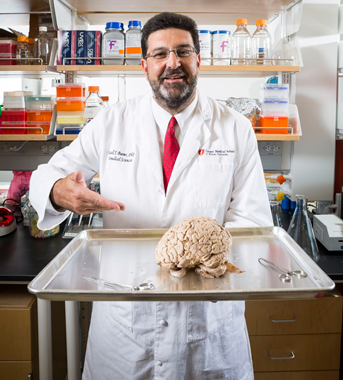Introducing Dr. Brain Dude: CMSRU professor teaches kids about their most important body part

The teenager was a little nervous about handling a real human brain. But her curiosity won out, and with gloved hands she gingerly cradled the yellow-gray, three-pound organ brought to her school by CMSRU faculty member Russell J. Buono, PhD.
It’s a once-in-a-lifetime opportunity,” says Emma Abbaszadeh, 17, recalling Buono’s presentation to her anatomy class at Cherry Hill High School West. “I’ll probably never be able to touch a brain again. It was so interesting!”
“The spinal cord was the weirdest part,” adds classmate Emily Adams, noting the tube-like structure’s “stringy” consistency. “I want to go into the medical field; this got me more excited.”
In fact, thousands of students have enjoyed the unique educational opportunity provided by Buono—known to his young audiences as “Dr. Brain Dude”—over the past 15-plus years. Since joining CMSRU in 2012, he has visited about two schools per month, including Camden public and charter schools, and others across South Jersey. And the quirky name? That came from an Ohio sixth-grader about 10 years ago, when Buono worked at the University of Cincinnati.
“It’s been super fun, trying to raise awareness of the brain and its function,” says the prominent neuroscientist, who brings an assortment of donated human and animal specimens to his talks.
For each gathering, Buono adjusts his presentation to the audience—from preschoolers to graduate students. He teaches about the brain’s myriad functions, how to keep it healthy, and the importance of studying the brain to help treat and prevent diseases.
“I’d give him an A-plus!” says Sondra Castellani, a science teacher who has hosted Dr. Brain Dude multiple times at Cherry Hill West.
“I have kids tell me this was the best thing we did all year,” adds Castellani. “It makes science not only accessible but interesting.”
“The brain affects everything. When people understand what it does for them, they quickly realize they’d prefer to keep it functioning properly.”
Making Science Fun
With younger children, Buono uses games to teach the science of the brain. For example, he demonstrates the connection between the brain and the senses by having children touch, smell and taste things they can’t see—and then try to identify the items.
He demonstrates the need to wear sports helmets by putting raw eggs in zip-lock bags and having the kids drop them on the floor. Then, he places tiny Styrofoam helmets on a second set of eggs—and the students are unable to break them.
“Mixing in fun goes a long way,” says the CMSRU professor and researcher, who spends about 10 percent of his time on Dr. Brain Dude and other community-service projects.
Among his activities, Buono helps conduct the Franklin Institute’s annual Brain Awareness Week, which he co-founded in 2000. He also presents to the public for both the Brain Injury Prevention Association of Pennsylvania and the Society for Neuroscience’s Philadelphia Chapter. Dr. Brain Dude even appeared in Vancouver, Canada, this spring at a Brain Health Fair hosted by the American Academy of Neurology.
These endeavors are a “natural fit” with CMSRU’s mission to serve the community, he notes.
Protecting the Brain
For older students and adults, Buono addresses more serious issues, including neurological diseases—the subject of much of his research. He shows preserved brains of people with various maladies, such as multiple sclerosis, cancer, stroke and Alzheimer’s disease.
That made a big impression on high school student Emily Adams, who was surprised to learn people can help stave off dementia as they age. “A way to keep your brain healthy is to make new connections; to learn new things like a hobby, foreign language, travel…”
Adams was struck by Dr. Brain Dude’s messages about sleep—a need that’s often neglected by teens. “Our brain is making all its connections while we’re sleeping… It made me feel better about taking lots of naps!”
Enhancing Understanding
Buono’s collection of about 20 animal brains is a hit with all ages. Starting with a pea-size mouse brain, he shows increasingly larger specimens, including those of a squirrel, pheasant, rabbit, deer, horse and dolphin.
Indeed, an animal’s brain “can help you understand some of their lifestyle,” explains Buono. In an opossum, for example, “the area responsible for the sense of smell is huge. It’s interesting to see how differences in behavior are reflected in differences in the brain.”
Buono’s medical students are involved, too, coordinating the Camden programs and joining him to interact with the children.
With the medical students, “the biggest thing is setting an example” of community service, the scientist explains. “I’m involved in the highest levels of teaching and research, but I take time out of my schedule to do this.”
That said, Dr. Brain Dude clearly enjoys volunteering. “When kids smile and the expression on their face shows you’ve gotten through to them, it’s very gratifying.”